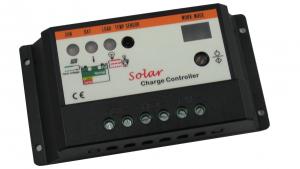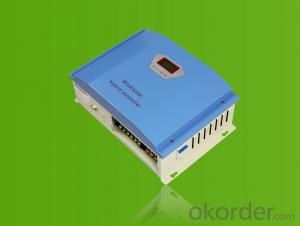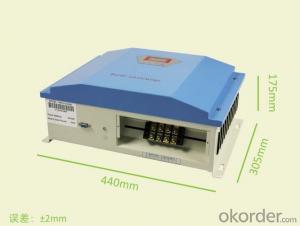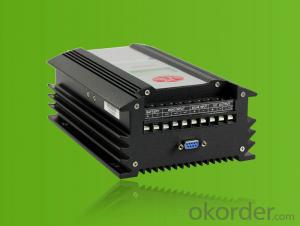2 Solar Charge Controllers in Parallel for Street Light System - Bygd SC1024S
- Loading Port:
- Shanghai
- Payment Terms:
- TT OR LC
- Min Order Qty:
- 10 unit
- Supply Capability:
- 50 unit/month
OKorder Service Pledge
OKorder Financial Service
You Might Also Like
1. Structure of BYGD Solar Charger Controller for Street light system Model SC1024S
This Solar Charger Controller is designed for street light system, which is updated with new technology to realize intelligentialization of control mode, and prolong service lifetime of all the components by improving the efficiency of operation. This Model is prior to the old generation in the aspects as follows: 12V/24V automatical adaption, control and set button changed into tact key, larger contact terminal can offer wire of 6 m2.
2. Main Features of BYGD Solar Charger Controllerfor Street light system Model SC1024S
◆ double LED digital display, clear for observation
◆ recharging mode by three phases
◆ PWM pulse modulated recharging technology
◆set light-dependent control and 1-13hous time control
◆short circuit protection, overvoltage protection, overcurrent protection and lighting protection
◆standy current no more than 5mA
3. BYGD Solar Charger Controllerfor Street light system Model SC1024S Images


4.BYGD Solar Charger Controllerfor Street light system Model SC1024S Specification
External Size:133mm×70mm
Mounting hole Size:126mm×50mm
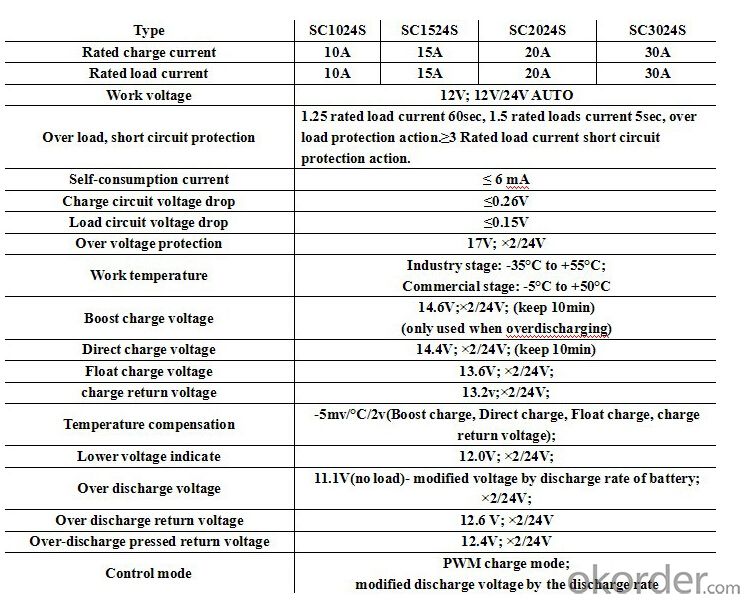
5. FAQ
(1) Why use PWM charge mode?
Our solar charger controller uses PWM in the main circuit for charge in order to reduce the voltage loss of the loop, which can improve the charging efficiency by 3-6% compared to the ones not useing PWM.
(2) What is the advantage of double digital display?
Double digital display make the code more clear and reasonable to show the correct mode so as to avoid misunderstanding.
(3)Is this new model more expensive that the old one?
Surely yes, because new model has the terminal bigger than that of the old model, which costs a few times more, the price of the product will be increased accrodingly.
- Q: Can a solar controller be used with a portable solar panel setup?
- Yes, a solar controller can be used with a portable solar panel setup. A solar controller helps regulate the flow of electricity from the solar panels to the batteries, preventing overcharging and optimizing the charging process. It is especially useful in portable setups to ensure efficient and safe charging of batteries.
- Q: Can a solar controller be used with a solar-powered recycling bin?
- Yes, a solar controller can be used with a solar-powered recycling bin. A solar controller regulates the flow of energy from the solar panels to the recycling bin's battery, ensuring proper charging and preventing overcharging. It helps optimize the performance and efficiency of the solar-powered recycling bin by managing the power input and output.
- Q: Can a solar controller be used with solar panels that are connected to a solar water pump?
- Yes, a solar controller can be used with solar panels that are connected to a solar water pump. A solar controller is an essential component of a solar power system as it regulates the voltage and current produced by the solar panels, ensuring that the energy is efficiently used and properly distributed to the connected devices. When a solar water pump is connected to solar panels, the solar controller helps in optimizing the power output and protecting the pump from overvoltage or overcurrent situations. It also monitors the battery status, if applicable, and ensures proper charging and discharging cycles. In summary, a solar controller plays a crucial role in managing and controlling the energy flow in a solar-powered water pump system, ensuring its optimal performance and longevity.
- Q: Can a solar controller be used with a solar-powered landfill gas extraction system?
- Yes, a solar controller can be used with a solar-powered landfill gas extraction system. The solar controller is responsible for regulating and managing the flow of electricity from solar panels to the system's components, such as pumps and motors. It ensures that the power generated by the solar panels is properly utilized, maximizing the system's efficiency and performance. Therefore, incorporating a solar controller into a solar-powered landfill gas extraction system is essential for its effective operation.
- Q: What is the maximum warranty period of a solar controller?
- The maximum warranty period of a solar controller varies depending on the manufacturer and model, but it is typically around 5 to 10 years.
- Q: Can a solar controller be used in a solar-powered heating system?
- Yes, a solar controller can be used in a solar-powered heating system. A solar controller is responsible for regulating the flow of electricity from the solar panels to the heating system, ensuring efficient operation and preventing overcharging of the batteries. It helps optimize the performance of the heating system by monitoring and adjusting the energy input based on the heating requirements.
- Q: Can a solar controller be used with a solar-powered greenhouse ventilation system?
- Yes, a solar controller can be used with a solar-powered greenhouse ventilation system. A solar controller regulates the amount of power flowing from the solar panels to the ventilation system, ensuring optimal performance and preventing overcharging. It helps to monitor and manage the energy generated by the solar panels, allowing for efficient and effective operation of the greenhouse ventilation system.
- Q: Can a solar controller handle power fluctuations from the inverter?
- Yes, a solar controller can handle power fluctuations from the inverter. The solar controller regulates and controls the flow of electricity from the solar panels to the battery bank, ensuring a stable and consistent power supply. It is designed to handle fluctuations in power output from the inverter and maintain a steady flow of energy to the batteries.
- Q: What is the role of a solar controller in preventing electrical surges in the solar panel system?
- Ensuring the safe and efficient operation of a solar panel system relies heavily on the crucial role of a solar controller. Also referred to as a charge controller, it is responsible for effectively managing the flow of charge between the solar panels and the batteries or grid-connected system. Among its primary functions is the prevention of electrical surges that have the potential to cause harm or damage to the solar panels, batteries, or other system components. Electrical surges can occur due to a variety of factors, including sudden changes in weather conditions, lightning strikes, or fluctuations in the power grid. These surges result in a sudden increase in voltage that surpasses the system's capacity, putting it at risk of damage or complete failure. To prevent such electrical surges, solar controllers employ a range of protective mechanisms. One common feature is voltage regulation, where the controller closely monitors the voltage levels of the solar panels and batteries. If the voltage surpasses a predetermined threshold, the controller takes action to limit the flow of charge, thereby preventing overcharging and potential surges. Moreover, advanced solar controllers often incorporate surge suppression devices or transient voltage suppressors. These devices are specifically designed to redirect excessive voltage or high-energy transient spikes away from sensitive components, ensuring their protection against any potential damage. In addition, solar controllers frequently include grounding mechanisms to guarantee proper grounding of the system. This grounding plays a significant role in dissipating any excess energy and directing it safely into the ground, minimizing the risk of electrical surges. To summarize, the role of a solar controller is crucial in preventing electrical surges within a solar panel system. By effectively managing charge flow, monitoring voltage levels, incorporating surge suppression devices, and implementing proper grounding, the solar controller ensures the long-term reliability and safety of the system, safeguarding it against electrical surges.
- Q: What is the maximum discharge current a solar controller can handle?
- The maximum discharge current that a solar controller can handle depends on its specifications and design. It can range from a few amperes to several hundred amperes, depending on the size and capacity of the controller.
Send your message to us
2 Solar Charge Controllers in Parallel for Street Light System - Bygd SC1024S
- Loading Port:
- Shanghai
- Payment Terms:
- TT OR LC
- Min Order Qty:
- 10 unit
- Supply Capability:
- 50 unit/month
OKorder Service Pledge
OKorder Financial Service
Similar products
Hot products
Hot Searches
Related keywords





